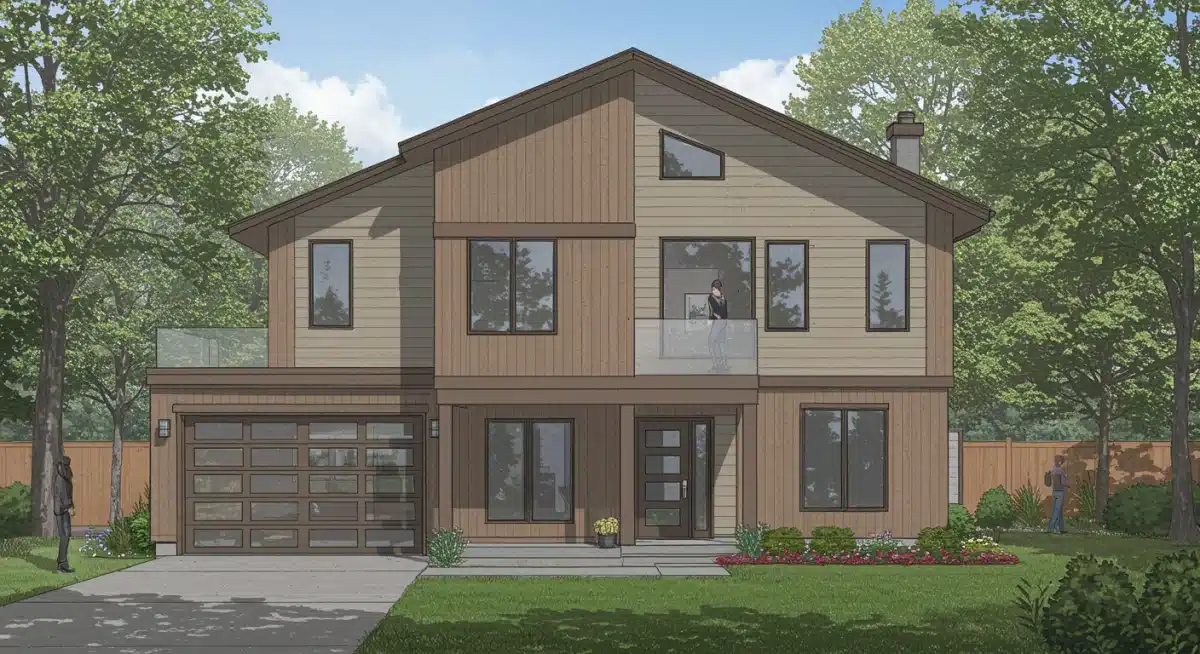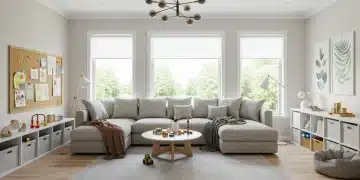Multi-Generational Living: Is It Right for Your Family in 2025?

Advertisement
Multi-generational living, a growing trend in 2025, involves multiple generations of a family residing under one roof, offering potential benefits like shared expenses, enhanced family bonds, and mutual support, yet also presenting unique challenges.
The landscape of family living in the United States is continuously evolving, and one of the most significant shifts we’re witnessing is the rise of multi-generational living: Is it right for your family in 2025? This question is becoming increasingly pertinent as more families consider the benefits and challenges of sharing a home with parents, grandparents, or adult children. Economic pressures, childcare needs, elder care concerns, and a desire for stronger family bonds are all contributing factors to this resurgence of a living arrangement that was once the norm. But what exactly does multi-generational living entail, and how can you determine if it’s the right path for your unique family dynamic in the coming year and beyond?
Understanding the Multi-Generational Living Trend in 2025
Multi-generational living, broadly defined, involves households composed of more than two generations. This could mean adult children living with their parents, grandparents living with their adult children and grandchildren, or even other combinations of relatives sharing a single residence. This living arrangement is not new; it has historical roots in many cultures and was common in the U.S. until the mid-20th century. However, economic shifts, changing social norms, and increasing life expectancies have fueled its modern resurgence, making it a prominent topic of discussion for families across the nation in 2025. This section explores the underlying forces driving this trend and offers a clearer picture of its contemporary manifestations.
Advertisement
Economic imperatives and housing affordability
One of the primary drivers behind the increase in multi-generational households is undoubtedly economic. The cost of living, particularly housing, has soared in many parts of the United States. For young adults burdened with student loan debt, finding affordable housing can be a significant challenge, making living with parents a practical solution. Similarly, for older adults on fixed incomes, pooling resources with family members can provide financial stability and peace of mind. This shared financial burden can alleviate stress for all involved, making homeownership or even stable renting more achievable.
- Shared utility costs: Dividing bills among more adults significantly reduces individual financial strain.
- Mortgage assistance: Multiple incomes can make qualifying for and affording a mortgage more feasible.
- Reduced childcare expenses: Grandparents often provide invaluable, cost-free childcare.
- Elder care savings: In-home care provided by family can be far more affordable than professional services.
Beyond the immediate financial relief, multi-generational living can also lead to long-term savings and wealth building. By consolidating expenses, families can allocate more funds towards savings, investments, or debt reduction, paving the way for greater financial security for all generations under one roof. The economic advantages are often the initial draw, but the subsequent benefits frequently extend far beyond mere monetary considerations, fostering a more resilient and interconnected family unit.
The trend is also influenced by the growing number of retirees seeking to age in place with support, and younger generations facing a competitive job market and high housing costs. These combined factors create a compelling argument for pooling resources and sharing responsibilities, making multi-generational living an increasingly attractive and necessary option for many families navigating the complexities of modern life. Understanding these economic underpinnings is crucial to appreciating why so many are asking if this model is right for their family in 2025.
Advertisement
The Benefits of Multi-Generational Living for Families
Beyond the financial advantages, multi-generational living offers a rich tapestry of benefits that can profoundly enhance family life. From strengthened emotional bonds to practical daily support, the shared living experience often fosters a deeper sense of community and connection within the family unit. This model provides a unique environment for mutual growth and support, allowing each generation to contribute and benefit in meaningful ways. Exploring these non-financial benefits reveals why this arrangement is gaining traction.
Enhanced family bonds and social support
Living together naturally facilitates more frequent and meaningful interactions between family members. Children benefit from having closer relationships with grandparents, who can impart wisdom, share family histories, and provide additional emotional support. Grandparents, in turn, often find renewed purpose and joy in being actively involved in their grandchildren’s lives. Parents experience the comfort of having a strong support system readily available, which can be particularly beneficial during stressful times or periods of transition. The daily presence of multiple generations can create a vibrant and nurturing home environment, fostering a sense of belonging and collective strength.

Practical advantages and shared responsibilities
The practical benefits of multi-generational living extend to daily tasks and responsibilities. Sharing chores, childcare duties, and even meal preparation can significantly reduce the burden on any single individual. For example, grandparents can assist with school pickups or homework, while adult children can help with household maintenance or transportation for older relatives. This division of labor frees up time for everyone, allowing for more leisure, personal pursuits, or simply more quality family time. The collective effort makes managing a household smoother and more efficient, enhancing the overall quality of life for all residents.
Furthermore, the presence of multiple adults can provide a safety net for unexpected situations. If a parent falls ill, there are other adults to step in and ensure children are cared for. If an elderly relative needs assistance, family members are on hand to provide immediate support. This built-in support system is invaluable, offering peace of mind and reducing the need for external, often costly, services. The collaborative nature of these households builds resilience and ensures that everyone’s needs are met within a caring environment, which is a powerful draw for families considering the multi-generational living model in 2025.
Navigating the Challenges of Shared Living Spaces
While the benefits of multi-generational living are compelling, it’s equally important to acknowledge and prepare for the challenges that can arise when multiple generations share a home. Blending distinct lifestyles, communication styles, and personal expectations under one roof requires deliberate effort, patience, and a strong commitment to compromise. Addressing these potential difficulties proactively is key to ensuring a harmonious living arrangement. This section delves into common hurdles and strategies for overcoming them, offering a realistic perspective for families considering this path.
Privacy concerns and personal space
One of the most frequently cited challenges in multi-generational households is the need for privacy and personal space. Each individual, regardless of age, requires their own sanctuary where they can unwind, pursue hobbies, or simply enjoy solitude. Without adequate private areas, friction can easily arise. Homes originally designed for nuclear families may not offer sufficient separation, leading to feelings of overcrowding or a lack of personal autonomy. It’s crucial to consider how the physical layout of the home can accommodate everyone’s need for personal boundaries.
- Dedicated bedrooms: Ensuring each adult or couple has their own private sleeping area.
- Separate living areas: Creating distinct spaces for different activities, like a TV room for children and a quiet lounge for adults.
- Soundproofing: Implementing measures to reduce noise transfer between private areas.
- Clear boundaries: Establishing rules around knocking before entering or respecting quiet hours.
Addressing privacy concerns often involves thoughtful home modifications or, ideally, choosing a home already designed with separate living quarters, such as an accessory dwelling unit (ADU) or a finished basement apartment. These solutions can provide the necessary physical separation, allowing each generation to maintain a sense of independence within the larger family structure. Without these considerations, even the strongest family bonds can be strained by the constant proximity.
Communication and Conflict Resolution in Multi-Generational Homes
Effective communication is the cornerstone of any successful shared living arrangement, and it becomes even more critical in multi-generational households. With varying perspectives, life experiences, and communication styles, misunderstandings can easily occur. Establishing clear channels for open dialogue and developing robust conflict resolution strategies are essential for maintaining peace and fostering a supportive environment. This section emphasizes the importance of these skills and offers practical advice for navigating interpersonal dynamics.
Establishing clear expectations and boundaries
Before moving in together, it is vital for all adult family members to have open and honest conversations about expectations, responsibilities, and boundaries. This includes discussions about finances, chore distribution, childcare roles, visitor policies, and even daily routines. Clearly defined roles and rules can prevent many potential conflicts by setting a framework for how the household operates. It’s not about rigid control, but about mutual understanding and respect for everyone’s needs and contributions.
Regular family meetings can serve as a valuable forum for discussing issues, sharing concerns, and adjusting expectations as needed. These meetings should be a safe space where everyone feels heard and respected, rather than a platform for blame. Active listening and empathy are crucial components of these discussions, ensuring that resolutions are collaborative and mutually beneficial. By investing time in these conversations, families can build a strong foundation for harmonious cohabitation.
Navigating differences in parenting and lifestyle
One common area of contention in multi-generational homes can be differences in parenting styles or lifestyle choices. Grandparents might have different ideas about discipline or screen time than parents, for instance. Similarly, varying opinions on diet, cleanliness, or social activities can lead to friction. It is important for all adults to respect each other’s roles and decisions, particularly regarding how parents choose to raise their children. Compromise and a willingness to find common ground are essential.

Finding a balance where everyone feels their voice is valued, and their needs are met, is an ongoing process. It requires flexibility and a commitment to the greater good of the family unit. When disagreements arise, focusing on solutions rather than assigning blame can help de-escalate tension. Sometimes, external mediation or counseling can be beneficial if families find themselves struggling to resolve persistent conflicts. Ultimately, the success of multi-generational living hinges on the family’s ability to communicate openly and resolve disputes constructively, ensuring that the living arrangement remains a source of strength, not stress.
Legal and Financial Considerations for Multi-Generational Households
Entering into a multi-generational living arrangement involves more than just emotional and logistical planning; it also carries significant legal and financial implications that need careful consideration. Addressing these aspects proactively can prevent future disputes and ensure that all parties are protected. From property ownership to shared expenses and estate planning, understanding the legal landscape is crucial for any family embarking on this journey in 2025. This section outlines key legal and financial points to consider, offering guidance on how to structure agreements for clarity and fairness.
Formalizing agreements and ownership structures
One of the most critical steps is to formalizing agreements regarding property ownership, financial contributions, and responsibilities. This can range from simple written agreements to more complex legal documents, depending on the specifics of the arrangement. For instance, if multiple generations are investing in a property, deciding on the ownership structure (e.g., joint tenancy, tenants in common) and how equity will be divided is paramount. A clear understanding of who owns what, who is responsible for which bills, and how major decisions will be made can prevent misunderstandings down the line.
- Co-ownership agreements: Legal documents outlining ownership percentages and responsibilities.
- Loan agreements: Formalizing contributions to mortgage payments or other shared debts.
- Estate planning updates: Reviewing wills and trusts to reflect new living arrangements and beneficiaries.
- Power of attorney: Establishing clear directives for healthcare and financial decisions for elderly relatives.
Consulting with legal and financial professionals is highly recommended to ensure all agreements are legally sound and fair to everyone involved. These professionals can help draft documents that protect all family members, clarify financial obligations, and address potential future scenarios, such as what happens if one party wishes to move out or if there is a change in financial circumstances. Taking these steps early can provide a robust framework for financial harmony and legal security within the multi-generational household.
Designing a Home for Multi-Generational Harmony
The physical environment plays a crucial role in the success of multi-generational living. A well-designed home can enhance privacy, promote independence, and facilitate positive interactions, while a poorly designed one can exacerbate tensions and create logistical nightmares. As families increasingly embrace this lifestyle in 2025, there’s a growing demand for homes that cater specifically to the needs of multiple generations. This section focuses on architectural and design considerations that contribute to a harmonious multi-generational living space.
Architectural solutions for shared and private spaces
When considering a multi-generational home, the layout should ideally provide both communal areas for family gatherings and private retreats for individual relaxation. Features like dual master suites, separate entrances, or even an attached accessory dwelling unit (ADU) can offer much-needed autonomy. These distinct living spaces allow different generations to maintain their routines and preferences without constantly encroaching on each other’s territory. The goal is to create a balance where family members feel connected yet also have the freedom to enjoy their personal space.
Beyond separate living quarters, universal design principles are paramount. This includes features like wider doorways, zero-entry showers, grab bars, and ramps, which benefit elderly residents and can also make the home more accessible for individuals with temporary mobility issues or young children. Thoughtful design anticipates the evolving needs of all residents, ensuring the home remains functional and comfortable for every stage of life. Investing in these design elements upfront can significantly improve the long-term viability and satisfaction of a multi-generational living arrangement, making the home a true sanctuary for all its inhabitants.
Is Multi-Generational Living Right for Your Family in 2025? Making the Decision
Deciding whether multi-generational living is the right choice for your family in 2025 is a significant decision that requires careful consideration of various factors. There’s no one-size-fits-all answer, as the suitability of this arrangement depends heavily on your family’s unique circumstances, personalities, and goals. Before committing to such a profound change, it’s essential to engage in thorough introspection and open communication with all involved parties. This final section provides a framework for evaluating if this lifestyle aligns with your family’s aspirations and practical needs, helping you make an informed choice.
Assessing family dynamics and individual needs
Start by honestly assessing your family’s dynamics. Are family members generally supportive and adaptable? Do they have a history of resolving conflicts constructively? Consider the individual needs and personalities of each person who would be living under the same roof. For instance, does an elderly parent require significant care, or are they largely independent? Do adult children value their privacy above all else, or are they comfortable with a more communal lifestyle? Understanding these nuances is crucial, as personality clashes or unmet needs can quickly undermine the benefits of shared living. A successful multi-generational household thrives on mutual respect, empathy, and a willingness to compromise.
Think about the practical implications for each family member. How will this change impact children’s routines, teenagers’ social lives, or adults’ work-life balance? Will there be adequate space for everyone’s belongings and activities? Consider the long-term vision: if circumstances change, how flexible is the living arrangement? Addressing these questions openly and honestly will help you identify potential sticking points and develop strategies to mitigate them. The process of deciding should be collaborative, ensuring that every voice is heard and every concern is validated.
The importance of trial periods and flexibility
For some families, a trial period might be a beneficial step before making a permanent commitment. This could involve an elderly parent staying for an extended visit or an adult child moving back home for a few months to test the waters. A trial period allows everyone to experience the realities of shared living firsthand, identify potential challenges, and adjust expectations without the pressure of a long-term commitment. It provides a valuable opportunity to refine communication strategies and establish routines that work for everyone.
Ultimately, the decision to embrace multi-generational living should be a collective one, rooted in a shared vision for the future. It’s about weighing the economic advantages against the potential for reduced privacy, balancing the benefits of mutual support with the need for individual autonomy. If your family values strong bonds, mutual support, and is willing to navigate the complexities with open communication and flexibility, then multi-generational living could indeed be a rewarding and sustainable solution for your family in 2025 and beyond. It represents a return to a more communal way of life, offering a powerful antidote to the isolation often experienced in modern society, and a chance to build a resilient and loving family unit for generations to come.
| Key Aspect | Brief Description |
|---|---|
| Economic Benefits | Shared expenses for housing, utilities, and childcare can significantly reduce financial burdens for all generations. |
| Family Bonds | Fosters stronger emotional connections, mutual support, and a deeper sense of community among family members. |
| Challenges & Solutions | Requires clear communication, established boundaries, and attention to privacy to overcome potential conflicts. |
| Home Design | Homes designed with separate living areas and universal accessibility features enhance harmony and independence. |
Frequently Asked Questions About Multi-Generational Living
A multi-generational household is typically defined as a home where at least two adult generations reside together. This often includes adult children living with their parents, or grandparents living with their adult children and grandchildren, creating a diverse family unit under one roof.
The primary financial benefits include shared housing costs like rent or mortgage payments, utilities, and groceries. Additionally, families can save significantly on childcare and elder care expenses, as family members often provide these services, easing overall financial strain.
Maintaining privacy requires intentional design and clear boundaries. Solutions include creating separate living areas, ensuring dedicated bedrooms, and establishing rules around personal space. Homes with accessory dwelling units (ADUs) or dual master suites are ideal for this purpose.
Challenges often include navigating differences in parenting styles, lifestyle preferences, and the need for clear communication to prevent misunderstandings. Establishing clear expectations for chores, finances, and personal space is crucial for harmonious cohabitation.
Yes, multi-generational living has been steadily increasing in the U.S. due to economic pressures, rising housing costs, childcare needs, and a desire for stronger family support systems. It’s a significant family trend continuing to grow in 2025.
Conclusion
As we navigate 2025, the conversation around the rise of multi-generational living: Is it right for your family in 2025? continues to gain momentum. This living arrangement, far from being a relic of the past, is proving to be a dynamic and adaptive solution for many modern families facing diverse economic, social, and personal challenges. While it offers undeniable benefits in terms of financial stability, emotional support, and enhanced family bonds, it also demands thoughtful planning, open communication, and a commitment to respecting individual needs and boundaries. The decision to embrace multi-generational living is a deeply personal one, requiring a thorough assessment of your family’s unique dynamics, aspirations, and practical considerations. By approaching this choice with careful deliberation, a willingness to compromise, and a focus on creating a supportive and harmonious environment, families can successfully navigate the complexities and unlock the profound rewards that this shared living experience has to offer, ultimately building a stronger, more resilient family unit for generations to come.





